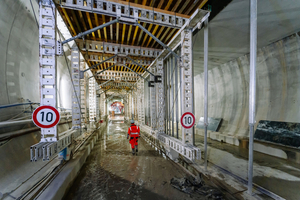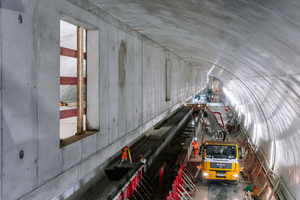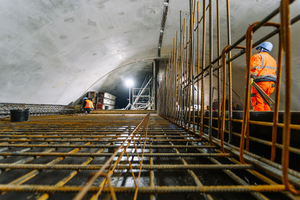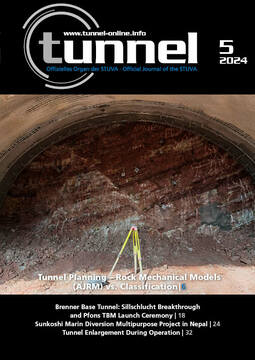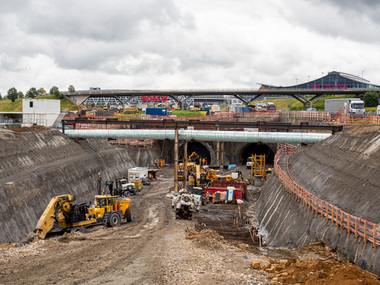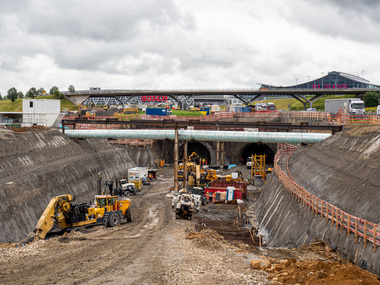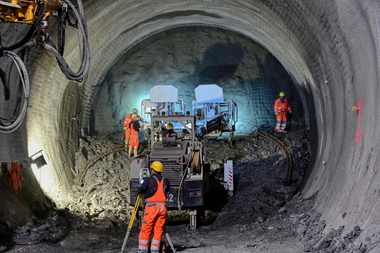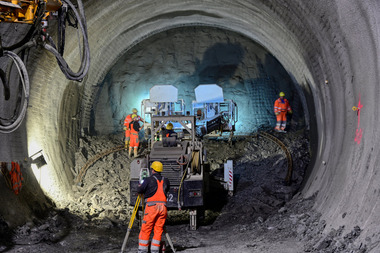Formwork Solutions for the Stuttgart 21
Airport Railway Station
The airport tunnel and the connected underground airport mainline and regional railway station are important components of Stuttgart 21, facilitating the previously time-consuming journey to and from the airport and trade fair centre. Their construction is being undertaken by the ARGE Flughafentunnel consortium (Züblin, Max Bögl, Strabag). The consortium is using various Noe formwork technology systems for the long-distance railway station to construct the smoke extraction ducts and the intersection between the tunnel tubes and the central access shaft.
Airport Tunnel and
Underground Railway Station
Stuttgart 21 is one of the largest and most complex infrastructure projects in Europe. However, many people only know that a futuristic-looking through station is replacing the historic terminus station in the centre of Stuttgart. However, the construction measures go much further: the relocation of the tracks underground will free up space for urban development. In addition, three further railway stations and tunnels with a total length of approx. 57 km are being built. This includes the airport tunnel with two 2.2 km long tubes.
The airport tunnel was excavated at a depth of up to 30 m using conventional mining methods. The construction of the tunnel was challenging as it runs under the A8 motorway and under several exhibition halls. The new long-distance and regional railway station is located on the Messepiazza in the immediate vicinity of the airport terminals and the S-Bahn and light rail stations. It is an important part of Stuttgart 21, as it connects the airport and trade fair centre to long-distance, regional and bus services. This will make it easier to reach other
cities. Currently, travellers have to take a journey of around 30 minutes to the main station in the city centre in order to continue their journey from there.
Formwork for the Smoke Extraction Ducts
To ensure that the tunnel and railway station also meet future requirements, both are equipped with appropriate safety technology. In the airport railway station, for example, there is a smoke extraction duct in each tube above the two approx. 430 m long platforms. The ARGE employees relied on several Noe-Schaltechnik systems for the construction of these ducts. These included NOEtec and NOEaluL. NOEtec is a flexible modular system that was developed for civil engineering and building construction. It consists of just a few components that can be used to create customised solutions. Accordingly, the Noe employees used it to plan four work carriages and two slab formwork carriages, transport the corresponding individual parts into the tubes and assemble them on site. The ceiling formwork carriages have a size of 5.0 x 16 m and are used to create the underside of the smoke extraction duct. The work trolleys are 4.5 x 16 m in size and enable the site workers to manage the tasks involved, such as filling the concrete.
All six carriages are designed so that construction site vehicles can drive underneath them while work is being carried out on the platforms. They stand on rails on which they are driven from one concreting section to the next. The two 25-tonne ceiling formwork carriages are equipped with an electric drive for this purpose. The lighter work carriages are moved using a construction site vehicle. The formwork tables of the ceiling formwork carriages rest on hydraulic rams, which can be lowered by up to 50 cm to release the formwork after the concrete has hardened. As soon as the suspended ceilings have been erected, the smoke shafts are closed at the sides using NOEaluL formwork. As the name suggests, this is made of aluminium and has a panel weight of less than 20 kg/m², making it extremely lightweight. As a result, it can be easily carried by hand. The NOEaluL also has the advantage that it can be transported easily thanks to its height of just 10 cm and can still withstand concrete pressures of up to 60 kN/m².
Intersection Between Access Shaft
and Tunnel Tubes
The main access to the two platforms is via an above-ground entrance building and a shaft, which is positioned centrally between the two tunnel tubes with a diameter of approx. 20 m. The inner intersecting surfaces between the two tunnel tubes and the shaft were concreted using special formwork that Noe planned and built for this project. When constructing the outer intersection area, the consortium employees relied on the NOEtop R 275 formwork system, which was developed for round, vertical components with a radius of 2.75 m or more. So that it can be used immediately, Noe supplies it with the radius required for the first use. Further radii can be set quickly and continuously. The NOEtop R 275 extension clamps make it easy to raise the circular formwork to the required height. It is fitted with the NOEform facing as standard. It enables the production of homogeneous concrete surfaces without pores and air pockets. To ensure that the concrete appearance matches the previously constructed shaft, Noe doubled the facing for the long-distance railway station project.

